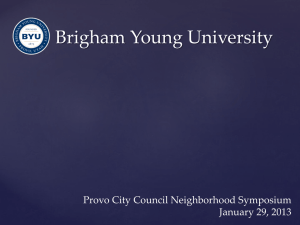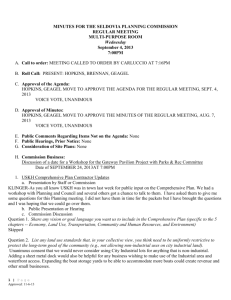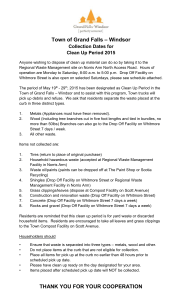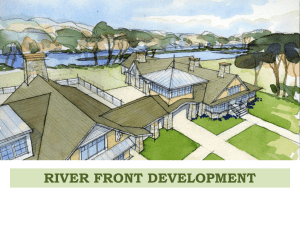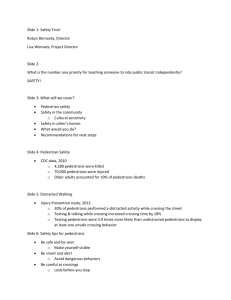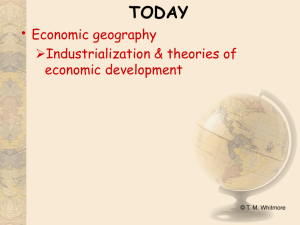Urban Design Advice on Site 10 Development Proposal
advertisement
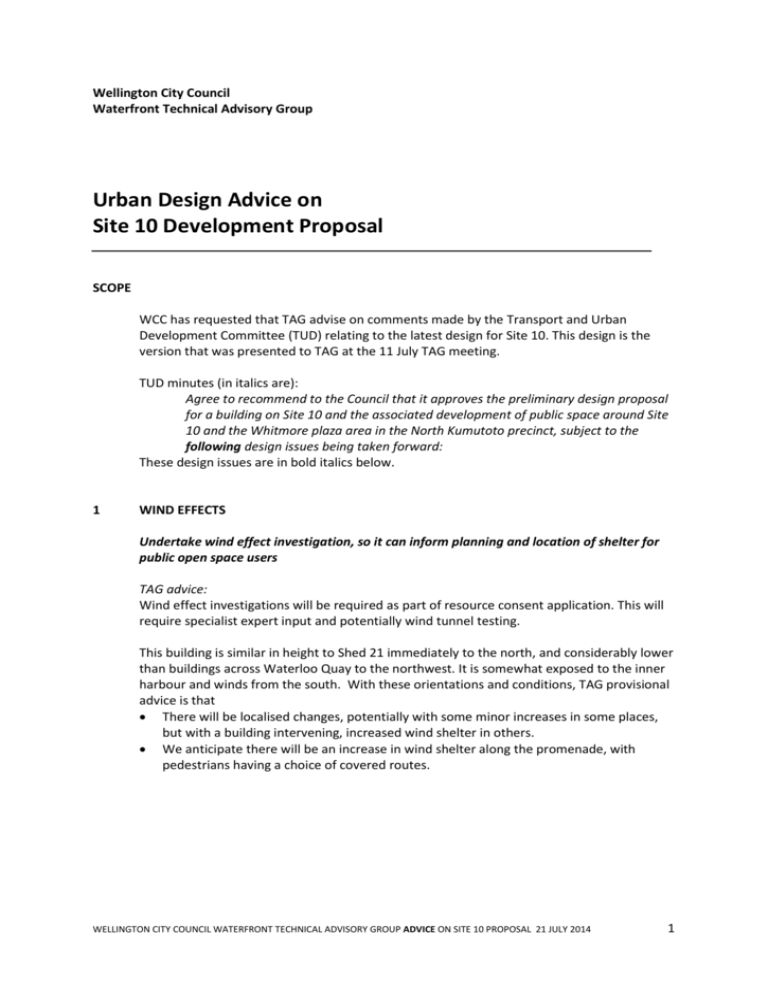
Wellington City Council Waterfront Technical Advisory Group Urban Design Advice on Site 10 Development Proposal SCOPE WCC has requested that TAG advise on comments made by the Transport and Urban Development Committee (TUD) relating to the latest design for Site 10. This design is the version that was presented to TAG at the 11 July TAG meeting. TUD minutes (in italics are): Agree to recommend to the Council that it approves the preliminary design proposal for a building on Site 10 and the associated development of public space around Site 10 and the Whitmore plaza area in the North Kumutoto precinct, subject to the following design issues being taken forward: These design issues are in bold italics below. 1 WIND EFFECTS Undertake wind effect investigation, so it can inform planning and location of shelter for public open space users TAG advice: Wind effect investigations will be required as part of resource consent application. This will require specialist expert input and potentially wind tunnel testing. This building is similar in height to Shed 21 immediately to the north, and considerably lower than buildings across Waterloo Quay to the northwest. It is somewhat exposed to the inner harbour and winds from the south. With these orientations and conditions, TAG provisional advice is that There will be localised changes, potentially with some minor increases in some places, but with a building intervening, increased wind shelter in others. We anticipate there will be an increase in wind shelter along the promenade, with pedestrians having a choice of covered routes. WELLINGTON CITY COUNCIL WATERFRONT TECHNICAL ADVISORY GROUP ADVICE ON SITE 10 PROPOSAL 21 JULY 2014 1 2 SHADE EFFECTS Undertake shade diagrams, so these can inform planning and location of shade for public open space users TAG advice: Shading diagrams will be provided as part of resource consent application. In advance of this, we anticipate that the building will shade various parts of public space at different times of the day and in different seasons. In particular the open space under the cantilever at the southern end of the building will receive both early morning and potentially and depending on the season, some afternoon sun. It is not anticipated that any space here will receive full day sun, however sunny areas must and will be available in the vicinity, as this proposed development is in the context of a system of public opens spaces where people can choose a location that is in the sun, or alternatively in the shade. 3 CONSULTATION Continue to seek input from Iwi and the Council’s Accessibility Advisory Group TAG advice: This is a matter for WWL, who advise that they have already consulted with AAG on the preliminary design of public space. 4 CREATIVE BUSINESS HUB Ensure that the Creative Business Hub feature is retained as the building design is developed TAG advice: This feature has been maintained in the current design. The intent of the Creative Business Hub should be defined, considering characteristics including but not limited to intended size of tenancies, means of providing for flexibility in use, relation to ‘shopfront’, and initiatives that would support activation and networking within. 5 VEHICLE AND PEDESTRIAN MOVEMENT AND SAFETY Ensure that issues of vehicle and pedestrian movement, lighting and safety are addressed TAG advice The general intention in this area is to provide a lane on the harbour side of buildings here between the light controlled intersection at Bunny Street and that at Whitmore Street, with a shared surface in front of the old Eastbourne Ferry Terminal Building linking to the open space at the south end of Site 10. At the Whitmore Street entry in front of the Eastbourne Ferry Terminal Building, users of the waterfront promenade must be able to move WELLINGTON CITY COUNCIL WATERFRONT TECHNICAL ADVISORY GROUP ADVICE ON SITE 10 PROPOSAL 21 JULY 2014 2 conveniently and safely to Site 10, to the edge of Waterloo Quay and north along the eastern side of Site 10 and Shed 21. Vehicle and pedestrian movement The space landward of the Eastbourne Ferry Terminal building can be designed to be a low speed pedestrian-priority shared surface. This will ensure that pedestrians have priority in moving to and from the water edge promenade to its extension along the edge of the Site 10 building, particularly at the crossing point. The WCC’s North Kumutoto Design Brief (adopted 22 November 2012) anticipates use of a pedestrian-priority shared surface: Pedestrians, cyclists and private, service and emergency vehicles may all share the same internal access space, while still giving pedestrians and cyclists priority over vehicles. The established precedent of the existing narrow lane extending south from Whitmore to Brandon demonstrates that vehicle and pedestrian access can both be safely accommodated in a lane here further to the north. Traffic Design Group observe: It is noted that at the time of the establishment of the Kumototo laneway, there was some concern that the laneway connection between Whitmore Street and Brandon Street (which was opened to vehicle traffic as part of those works) would become a parallel ‘rat run’ to the heavily trafficked Customhouse Quay. This concern has not materialised. In the same way, the retention of the existing connection between Bunny Street and Whitmore Street as part of this proposal is expect to similarly operate as existing, providing access to only those essential activities which front the laneway and will not introduce a rat-run. While vehicle access through a shared surface is possible, it is not an attractive movement option for vehicles other than those servicing buildings and activities here. That is because of natural speed restriction and entrance and exit complication relative to the adjacent Quays route. There is simply no incentive to use this as a through route other than when accessing the buildings here, and an environment that because of its narrowness and configuration at entrances is intended to and will restrict the ability to speed. Managed vehicle access to the Eastbourne Ferry Building and Site 10 is required on occasion to fully perform the function and utilise the amenities of these buildings. Dropoff locations ensure access for people with a range of levels of mobility. Two-way access is important. Traffic Design Group have advised: The establishment of a two-way lane is considered preferable to a one-way lane, as this will allow the in and outbound traffic to be spread over the adjacent intersections (rather than all ‘loading’ into and out of one point). It also enables flexibility of use of the area – a one-way lane would introduce the undesirable need for local traffic to circulate via the Quays. Two way access also means that those vehicles that do enter to service activities here will be able to exit without having to turn around on the promenade. A requirement for turning from both the north and south would compromise the environment for pedestrians. Two way access also reinforces the requirements for care on the part of all WELLINGTON CITY COUNCIL WATERFRONT TECHNICAL ADVISORY GROUP ADVICE ON SITE 10 PROPOSAL 21 JULY 2014 3 users and furthers the suite of design tools that demand slow speed of cyclists and vehicles. The shared surface maximises possibilities for future co-operative development on Centreport while containing all required movements within waterfront land. The attractive environment possible in a shared space provides a quality address for any future CentrePort activities. Should events associated with the Promenade and or Site 10 require, the shared surface could easily be managed as pedestrian only for duration of the event. Pedestrians also have a choice of pedestrian-only and covered routes on both the Waterloo Quay and harbour side of the building. Safety Shared surfaces with pedestrian priority are already in use on Wellington’s waterfront. These include around the Taranaki Wharf gates, and at the base of the Clyde Quay Wharf and close to Oriental Parade, where the promenade already successfully crosses vehicle access routes. Broad speed tables where the focus is clearly on pedestrian movement in combination with a narrow carriageway has created an environment on the lane from Whitmore south to Brandon that is proving to be safe and well used by the intended groups. This includes broad speed tables opposite Waring Taylor and Johnston Streets. Shared streets are proving successful in Auckland with Fort, Elliott and Darby Streets, and Lorne Street in front of the Auckland Public Library. Design details which reinforce the shared nature of the surface e.g. special paving, provide multiple alerts to drivers of a different driving environment e.g. narrow width, textural change and that improve the quality of the environment without losing access are readily implemented at the design development stage. Lighting Lighting is readily dealt with through design development. The proposed building configuration and its related open space offers the conditions where safety and amenity lighting can be expected to be successfully installed. Lighting will be compatible with the Draft Lighting Masterplan which forms a framework and strategies for public space on the waterfront within which individual developments sit. WELLINGTON CITY COUNCIL WATERFRONT TECHNICAL ADVISORY GROUP ADVICE ON SITE 10 PROPOSAL 21 JULY 2014 4


